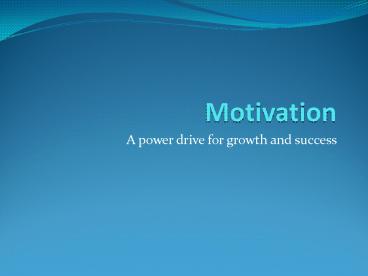Motivation
1 / 36
Title:
Motivation
Description:
... a skilled performance which satisfies the creative instinct in a man. ... evident when people engage in an activity for its own sake, without some obvious ... – PowerPoint PPT presentation
Number of Views:19
Avg rating:3.0/5.0
Title: Motivation
1
Motivation
- A power drive for growth and success
2
Objectives
- Understand Motivation and the types of motivation
- Understand various theories of motivation
- Relevance of student motivation
- Relevance of motivation for an organization
- Understand the 7 rules of motivation
- Characteristics of a good motivator
- Inspiration v/s Motivation
- How to avoid demotivation
3
What is Motivation???
- Motivation Motive Action
- Motive That which induces a person to act in a
certain way i.e. a desire, fear, reason which
influences a persons power of choosing and
deciding himself. - Action Refers to inducing this motive
- Motivation is an amplifying factor for
performance i.e. Performance Motivation x
(Knowledge Skill Ability) - Types of Motivation
- Intrinsic Motivation
- Extrinsic Motivation
4
Intrinsic Motivation
- Intrinsic motivation is the sense of satisfaction
a person gets after a skilled performance which
satisfies the creative instinct in a man. - Intrinsic motivation is evident when people
engage in an activity for its own sake, without
some obvious external incentive present. A hobby
is a typical example. - Intrinsic motivation has been intensely studied
since the 1970s, and numerous studies have found
it to be associated with high educational
achievement and enjoyment by students. - Intrinsic motivation comes from within oneself.
- Intrinsic motivation is far more powerful than
Extrinsic Motivation
5
Factors Promoting Intrinsic Motivation
6
Extrinsic Motivation
- Extrinsic motivation includes the recognition and
the support received from the external sources
like financial incentives, appreciation,
admiration, of others, timely promotions etc. - Extrinsic motivation is when I am motivated by
external factors, as opposed to the internal
drivers of intrinsic motivation. Extrinsic
motivation drives me to do things for tangible
rewards or pressures, rather than for the fun of
it. - Supermarkets use loyalty cards and discounts,
airlines use air miles, companies use bonuses and
commissions. Extrinsic motivation is everywhere
7
General Strategies Teachers Adopt
- Capitalize on students' existing needs.
- Make students active participants in learning.
- Hold high but realistic expectations for your
students. - Avoid creating intense competition among
students.
8
Scene 1
9
SCENE 2
10
Responding To Their Work
- Give students feedback as quickly as possible.
- Reward success.
- Introduce students to the good work done by their
peers. - Be specific when giving negative feedback.
11
(No Transcript)
12
Theories Of Motivation
13
Need Hierarchy Theory
Abraham Maslow
- Human beings have wants and desires which
influence their behaviour only unsatisfied needs
can influence behaviour, satisfied needs cannot. - Since needs are many, they are arranged in order
of importance, from the basic to the complex. - The person advances to the next level of needs
only after the lower level need is at least
minimally satisfied. - The further the progress up the hierarchy, the
more individuality, humanness and psychological
health a person will show.
14
Need Hierarchy Theory
- Physiological needs - The individual moves up
the ladder responding first to the basic needs
for nourishment, clothing and shelter. - Safety Needs Once physiological needs are
satisfied, the need to be free from danger,
either from the people or environment, emerges
Individual wants to be assured about safety
aspect. The safety needs may take the form of job
security, security against disease, misfortune,
old age etc - Social Needs After the above two are met,
social or affiliation needs emerge since man is a
social being. He needs to belong and to be
accepted in the society. It may also be termed as
love need or the need to feel accepted. - Esteem Needs Now the person wants to be
accepted as someone distinguished person and not
just a member of the group. The esteem need
includes both self esteem and recognition and
respect from others. The esteem level represent
the higher needs like power achievement, status. - Self Actualisation Now it comes to the fore.
This level represents the culmination of lower,
middle and higher need levels. In simple words,
it is the maximisation of ones potential in his
field. What a man can be, he must be.
15
Herzbergs Two Factor Theory
- Frederick Herzberg's two factor theory, concludes
that certain factors in the workplace result in
job satisfaction, while others do not, but if
absent lead to dissatisfaction. - He distinguished between
- Motivators (e.g. challenging work, recognition,
responsibility) which give positive satisfaction - Hygiene factors (e.g. status, job security,
salary) which do not motivate if present, but if
absent will result in demotivation. - The name Hygiene factors is used because, like
hygiene, the presence will not make you
healthier, but absence can cause health
deterioration. - The theory is sometimes called the
"Motivator-Hygiene Theory."
16
Two Factor Theory
17
Cognitive Dissonance
18
Goal Setting Theory
19
Relevance of Motivation in an Organisation
20
(No Transcript)
21
(No Transcript)
22
(No Transcript)
23
(No Transcript)
24
(No Transcript)
25
(No Transcript)
26
(No Transcript)
27
(No Transcript)
28
(No Transcript)
29
(No Transcript)
30
Characteristics of a good motivator
- Good Communication Skills
- Giving appraisals
- Avoid negative criticism
- Authoritative style not always effective
- Throw challenge
- Building positive attitude
31
7 Rules of Motivation
- Set a major goal, but follow a path
- Finish what you start.
- Socialize with others of similar interest.
- Learn how to learn.
- Harmonize natural talent with interest that
motivates. - Increase knowledge on subjects that inspires.
- Bounce Back.
32
Inspiration Motivation ?
Inspired!!
Motivated
Motivated
Motivated
Motivated
Motivated
33
Avoiding Demotivation
34
(No Transcript)
35
(No Transcript)
36
Thank You
This presentation can be downloaded from
http//www.arun.parthasarathy.name
- Created Using































